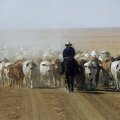
Grain growers across Australia face a high risk of reduced wheat harvests this winter due to a strengthening El Niño event, a University of Queensland plant science expert warns.
Dr Andries Potgieter produces the monthly OZ-Wheat regional wheat yield forecasts developed from climate data and modelling, remote sensing and historical data.
“The July modelling suggests that the likely impact of El Niño on the winter crop this season could be very significant,” Dr Potgieter said.
“Wheat growers throughout Australia face a high-risk of low yielding crops for the 2015 winter cropping season, but the effect will vary from region to region,” he said.
Dr Potgieter is a scientist at the Queensland Alliance for Agriculture and Food Innovation (QAAFI), a joint venture between UQ and Queensland Government.
 He has generated a forecast crop map (Figure shown: © QAAFI and QDAF) that shows likely yield outcomes and incorporates effects of soil moisture and projected rainfall and temperatures based on the Southern Oscillation Index (SOI).
He has generated a forecast crop map (Figure shown: © QAAFI and QDAF) that shows likely yield outcomes and incorporates effects of soil moisture and projected rainfall and temperatures based on the Southern Oscillation Index (SOI).
“The El Niño and La Niña weather patterns are a part of a natural cycle known as the El Niño Southern Oscillation (ENSO), which can strongly influence year-to-year climate variability in Australia,” he said.
He advised growers to talk to their agronomists about crop decisions to suit their farm and region.
“Using appropriate maturity cultivars, adjusting input management in response to known soil water profiles, or even changing the crop-type could help grain growers to better manage the likely impact of this El Niño event,” he said.
“Because it’s early in the winter cropping season, sowing can still occur in some areas until middle to late July in most of the cropping regions.
“However, growers should follow the ENSO status closely over the next month or two and adjust management based on the likely risks.”
This phenomenon can have effects right through the supply chain and influence export trade.
Dr Potgieter said the El Niño was often associated with drought in Australia, and severe El Niño events in 2002 and 2006 had detrimental effects on crops, leading to a reduction of Australia’s total gross domestic product.
Media: Professor Graeme Hammer: +61 7 3346 9463, g.hammer@uq.edu.au or QAAFI Communications: Margaret Puls, 0419 578 356, m.puls@uq.edu.au.
Bottom image caption (© QAAFI and QDAF): Areas shaded in yellow to red are forecast to obtain less than average yield, whereas colours in green to blue have a high chance of obtaining above average yield.
For editors:
The seasonal 'OZ-Wheat Regional Scale Crop Simulation Model' wheat outlook is based on the integration of:
(i) a simple agro-climatic wheat stress index model (OZ-Wheat)
(ii) actual climate data up to the forecasting date and
(iii) projected climate data after that date. These projected data are drawn from historical analogue years based on similarity to the prevailing phase of the Southern Oscillation Index (SOI).
The Oz-Wheat model is run from 1 October the year prior sowing, in order to account for the influence of the winter fallow on starting soil moisture conditions. The model shire input parameters (i.e. plant available water content, planting rain & stress index period) have been selected based on the best fit when calibrated against actual shire wheat yields from the Australian Bureau of Statistics (ABS) for the period 1975 - 1999.
Spatial correlation when predicting the shire wheat yields for the 2000 season is 0.8 across all main wheat producing shires of Australia (245 in total).
.jpg)











